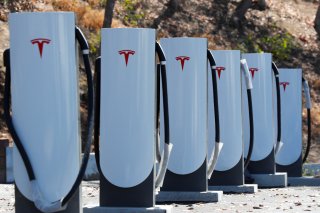When Will Non-Tesla Electric Cars Get Their Own Superchargers?
In June, Tesla deployed its 35,000th Supercharger.
According to Tesla, the company launched what it called a “Non-Tesla Supercharger pilot” program last November.
“Access to an extensive, convenient, and reliable fast-charging network is critical for large-scale EV adoption,” the company says on its support site. “That’s why, since opening our first Superchargers in 2012, we have been committed to rapid expansion of the network. Today, we have more than 35,000 Superchargers worldwide.”
“It’s always been our ambition to open the Supercharger network to Non-Tesla EVs, and by doing so, encourage more drivers to go electric,” Tesla added. Per Electrek, Tesla has expanded this program more into Europe, adding Denmark, Finland, Germany, Luxembourg, and Switzerland.
Now, the program is headed to the United States, where Tesla is headquartered and has long done most of its business.
Back in June, the White House touted, as part of a fact sheet, about $700 million in private-sector commitments to electric vehicle charging, that would make electric vehicles more affordable.
“Tesla is making investments at its Gigafactory in Buffalo, New York to support the deployment of new fast charging stations to add to its fast-charging network,” the White House said.
“Tesla is expanding production capacity of power electronics components that convert alternating current to direct current, charging cabinets, posts and cables. Later this year, Tesla will begin production of new Supercharger equipment that will enable non-Tesla EV drivers in North America to use Tesla Superchargers.”
In June, Tesla deployed its 35,000th Supercharger.
In the second quarter of 2022, Tesla announced, as expected, that it delivered fewer cars than it had the quarter before, its first negative quarter in two years. The company produced over 258,000 vehicles and delivered over 254,000 vehicles in the second quarter. The drop was attributed to Covid-19-related shutdowns in China and supply chain issues.
“While the year started out with 1.5 million to 1.6 million units as the bogey for 2022 deliveries (with a stretch goal of 1.7 million), now the whisper bogey is closer to 1.4 million for the year given the China issues coupled with global supply chain issues,” analyst Daniel Ives of Wedbush Securities, said in a note following the release.
“We believe already baked into the stock at current levels after significant weakness seen the last few months is a lower delivery trajectory and headline hit to numbers for the June quarter,” Ives continued.
“The Street is now focused on 2H (likely up 40%-50% from 1H barring no more major China zero Covid issues) deliveries and 2023 numbers as a more normalized environment to gauge the overall health of Tesla's delivery trajectory and top-line/EPS. We also note that while Giga Berlin and Austin factories are in significant ramp mode, this is a significant production capacity expansion for 2023 and beyond.”
Stephen Silver, a technology writer for The National Interest, is a journalist, essayist, and film critic, who is also a contributor to The Philadelphia Inquirer, Philly Voice, Philadelphia Weekly, the Jewish Telegraphic Agency, Living Life Fearless, Backstage magazine, Broad Street Review, and Splice Today. The co-founder of the Philadelphia Film Critics Circle, Stephen lives in suburban Philadelphia with his wife and two sons. Follow him on Twitter at @StephenSilver.
Image: Reuters.

